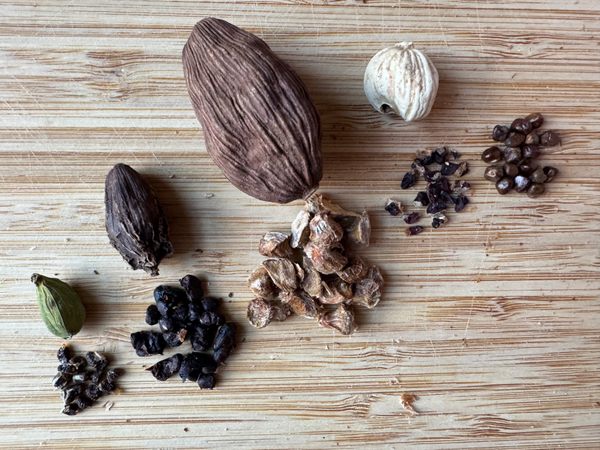A Guide to the Cardamoms of the World
This article is adapted from the February 15, 2025, edition of Gastro Obscura’s Favorite Things newsletter. You can sign up here. My favorite source for Thai recipes is Pailin Chongchitnant’s blog and YouTube channel Hot Thai Kitchen, and I recently decided to make her Thai-style biryani. Thailand has a lot of Indian influence, and I was intrigued to learn there was a Thai version of what I usually think of as a South Asian dish. I was also interested to notice two differences from typical South Asian biryanis in the spices Chongchitnant uses. Her recipe calls for bay laurel, which I know as the bay leaf of China and Europe, rather than the bay leaf of India. And the cardamom she uses was neither of the two kinds I was familiar with from cooking Indian food (green and black). It turns out that the typical cardamom in Thailand and other Southeast Asian countries is a third species called white cardamom. Green cardamom pods are sometimes bleached and sold under that name, but true white cardamom is almost spherical in shape, with a mild flavor. I was able to find white cardamom pods for my biryani relatively easily at a Chinese grocery store in my neighborhood. But, confusingly, I noticed that they were labeled as tsaoko, a name that usually refers to yet another kind of cardamom. There are at least five different entries in the cardamom expanded universe. Cousins of ginger, turmeric, and lesser-known culinary gems like galangal, all cardamoms carry a distinctive cocktail of scent chemicals, like terpinyl acetate, also found in pine, and cineole, also found in sage, eucalyptus, and bay leaf. But each has its own unique qualities.This week, Gastro Obscura is diving into the surprisingly diverse world of cardamoms, with a primer on the major types and how to use them. Green Cardamom (Elettaria cardamomum) I tend to associate green cardamom with Persian or Indian desserts, but the popular and versatile “Queen of Spices” features in a staggering variety of sweet and savory dishes, beverages, and spice blends across much of Asia and Africa. It’s also popular for traditional sweets like cardamom buns in Sweden, which consumes about 60 percent more cardamom per capita than the U.S. The green cardamom plant favors a tropical climate and is said to have originated in South India, where it is still cultivated extensively. There’s even a region in the state of Kerala called the Cardamom Hills. Pods start out as ripe fruits, which are painstakingly harvested by hand and dried in the sun. There are two major varieties, both named for regions in South India. Mysore pods are pointier, while Malabar pods are more rounded. Mysore cardamom is also more prized—and expensive—due to its brighter color and stronger fragrance. Malabar pods are the ones sometimes sold as false “white cardamom.” Be wary of inferior relatives marketed as the real thing: One such impostor was even known historically as “bastard cardamom.” Black or Brown Cardamom (Amomum subulatum) Unlike green, black cardamom is almost exclusively used in savory cooking, and is not widely popular outside its native South Asia. While it doesn’t make a good substitute for green cardamom, especially in desserts, black cardamom is versatile in its own way. Its strength and depth allows it to complement gamy meats like goat, as well as enhance otherwise mild ingredients like lentils and rice. Cultivation of black cardamom is concentrated in the Himalayas, as the plant prefers a cooler, drier climate. The pods have a distinctive smoky flavor and aroma for a simple reason: They’re smoked. The ripe fruits are tomato-red when picked, but drying over an open flame darkens them and adds to their already powerful flavor, with deep notes of camphor, menthol, and pine. Jonathan Soma of education center The Brooklyn Brainery describes it as smelling “like a medicinal campfire,” an assessment I agree with. In Hindi and Urdu, the two major cardamoms are often distinguished by size rather than color. Black is moti or badi elaichi, both meaning “big cardamom,” while green is choti elaichi, “little cardamom.” Black cardamom pods are not only larger but tougher to open, so they’re usually added to dishes whole after tempering (frying to release flavor), but they can also be powdered. Mrs. Balbir Singh’s Indian Cookery Book, a North Indian classic originally published in 1961, favors black cardamom over green for garam masala. However, both cardamoms are often used together, in recipes like this chicken biryani. Chinese Black Cardamom (Lanxangia tsao-ko) I still remember how excited I was the first time I saw tsaoko at a Chinese grocery store several years ago (since then, it seems to have become more widely available). Also called cǎoguǒ, from its Mandarin name, and Amomum tsao-ko (from its former scientific name), tsaoko is comparable to black cardamom in appearance and smoky flavor, but its pods and seeds are much larger. The spice is primarily used in western China

This article is adapted from the February 15, 2025, edition of Gastro Obscura’s Favorite Things newsletter. You can sign up here.
My favorite source for Thai recipes is Pailin Chongchitnant’s blog and YouTube channel Hot Thai Kitchen, and I recently decided to make her Thai-style biryani. Thailand has a lot of Indian influence, and I was intrigued to learn there was a Thai version of what I usually think of as a South Asian dish. I was also interested to notice two differences from typical South Asian biryanis in the spices Chongchitnant uses. Her recipe calls for bay laurel, which I know as the bay leaf of China and Europe, rather than the bay leaf of India. And the cardamom she uses was neither of the two kinds I was familiar with from cooking Indian food (green and black).
It turns out that the typical cardamom in Thailand and other Southeast Asian countries is a third species called white cardamom. Green cardamom pods are sometimes bleached and sold under that name, but true white cardamom is almost spherical in shape, with a mild flavor. I was able to find white cardamom pods for my biryani relatively easily at a Chinese grocery store in my neighborhood. But, confusingly, I noticed that they were labeled as tsaoko, a name that usually refers to yet another kind of cardamom.
There are at least five different entries in the cardamom expanded universe. Cousins of ginger, turmeric, and lesser-known culinary gems like galangal, all cardamoms carry a distinctive cocktail of scent chemicals, like terpinyl acetate, also found in pine, and cineole, also found in sage, eucalyptus, and bay leaf. But each has its own unique qualities.
This week, Gastro Obscura is diving into the surprisingly diverse world of cardamoms, with a primer on the major types and how to use them.

Green Cardamom (Elettaria cardamomum)
I tend to associate green cardamom with Persian or Indian desserts, but the popular and versatile “Queen of Spices” features in a staggering variety of sweet and savory dishes, beverages, and spice blends across much of Asia and Africa. It’s also popular for traditional sweets like cardamom buns in Sweden, which consumes about 60 percent more cardamom per capita than the U.S.
The green cardamom plant favors a tropical climate and is said to have originated in South India, where it is still cultivated extensively. There’s even a region in the state of Kerala called the Cardamom Hills. Pods start out as ripe fruits, which are painstakingly harvested by hand and dried in the sun. There are two major varieties, both named for regions in South India. Mysore pods are pointier, while Malabar pods are more rounded. Mysore cardamom is also more prized—and expensive—due to its brighter color and stronger fragrance.
Malabar pods are the ones sometimes sold as false “white cardamom.” Be wary of inferior relatives marketed as the real thing: One such impostor was even known historically as “bastard cardamom.”

Black or Brown Cardamom (Amomum subulatum)
Unlike green, black cardamom is almost exclusively used in savory cooking, and is not widely popular outside its native South Asia. While it doesn’t make a good substitute for green cardamom, especially in desserts, black cardamom is versatile in its own way. Its strength and depth allows it to complement gamy meats like goat, as well as enhance otherwise mild ingredients like lentils and rice.
Cultivation of black cardamom is concentrated in the Himalayas, as the plant prefers a cooler, drier climate. The pods have a distinctive smoky flavor and aroma for a simple reason: They’re smoked. The ripe fruits are tomato-red when picked, but drying over an open flame darkens them and adds to their already powerful flavor, with deep notes of camphor, menthol, and pine. Jonathan Soma of education center The Brooklyn Brainery describes it as smelling “like a medicinal campfire,” an assessment I agree with.
In Hindi and Urdu, the two major cardamoms are often distinguished by size rather than color. Black is moti or badi elaichi, both meaning “big cardamom,” while green is choti elaichi, “little cardamom.” Black cardamom pods are not only larger but tougher to open, so they’re usually added to dishes whole after tempering (frying to release flavor), but they can also be powdered. Mrs. Balbir Singh’s Indian Cookery Book, a North Indian classic originally published in 1961, favors black cardamom over green for garam masala. However, both cardamoms are often used together, in recipes like this chicken biryani.
Chinese Black Cardamom (Lanxangia tsao-ko)
I still remember how excited I was the first time I saw tsaoko at a Chinese grocery store several years ago (since then, it seems to have become more widely available). Also called cǎoguǒ, from its Mandarin name, and Amomum tsao-ko (from its former scientific name), tsaoko is comparable to black cardamom in appearance and smoky flavor, but its pods and seeds are much larger.
The spice is primarily used in western China, in dishes like Lanzhou noodle soup and Sichuan hot pot. Chinese chefs typically add tsaoko to soups and meat braises, allowing the flavor to seep into liquid over long cooking times. As far back as the 14th century, Hu Sihui, an imperial dietician, included tsaoko pods in many of his soup recipes (including one for wolf meat). Tsaoko is also used to flavor phở in Vietnam, where it’s known as thảo quả.

White or Siam Cardamom (Wurfbainia vera)
Scottish botanical illustrator Elizabeth Blackwell dubbed this species Amomum verum in 1757, making it the first plant to be scientifically named by a woman. However, like tsaoko, the species was later reclassified and given a new scientific name. This native Southeast Asian spice gives its name to the Cardamom Mountains that span Cambodia and Thailand. True white cardamom pods are almost spherical, unlike bleached green cardamom, which is flatter and more oval.
In my Thai biryani, white cardamom was lightly toasted and ground to mingle its delicate flavor with other spices like coriander seed and cinnamon. It’s also commonly included in the paste that forms the base of Cambodian and Indonesian curries.
Ethiopian Cardamom (Aframomum corrorima)
If you’ve tasted Ethiopian food, you’ve probably tasted Ethiopian cardamom, or korerima. That’s because it’s usually included in the spice blend berbere and the spice-infused ghee niter kibbeh, which are foundational to many Ethiopian recipes, and this is how I’ve used it in the past. Korerima also flavors Ethiopian coffee and other spice blends, like sweet, warming mekelesha, which is sprinkled onto dishes as a finishing touch.
Native to East Africa, korerima is closely related to grains of paradise, and carries a similar hint of peppery brightness with notes of citrus. This cardamom can be trickier to source than the others, but the seeds are sold by online vendors, often pre-removed from the pod. Though more versatile than black cardamom, korerima is stronger than green, so a little goes a long way.


































































-Baldur’s-Gate-3-The-Final-Patch---An-Animated-Short-00-03-43.png?width=1920&height=1920&fit=bounds&quality=70&format=jpg&auto=webp#)
































































































































































































